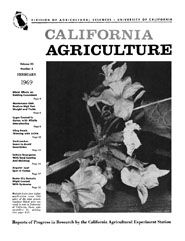


University of California
California Agriculture



|
|||
|
|||

Cover:
Multiple fruits from higher application rates (250 ppm) of the plant growth regulator Ethrel were one: result in tests at University of California, Davis, with cucumbers for pickling.
February 1969
Volume 23, Number 2 News and opinion |
|||
|
University of California, 1301 S. 46th St., Bldg. 478 Richmond, CA
|